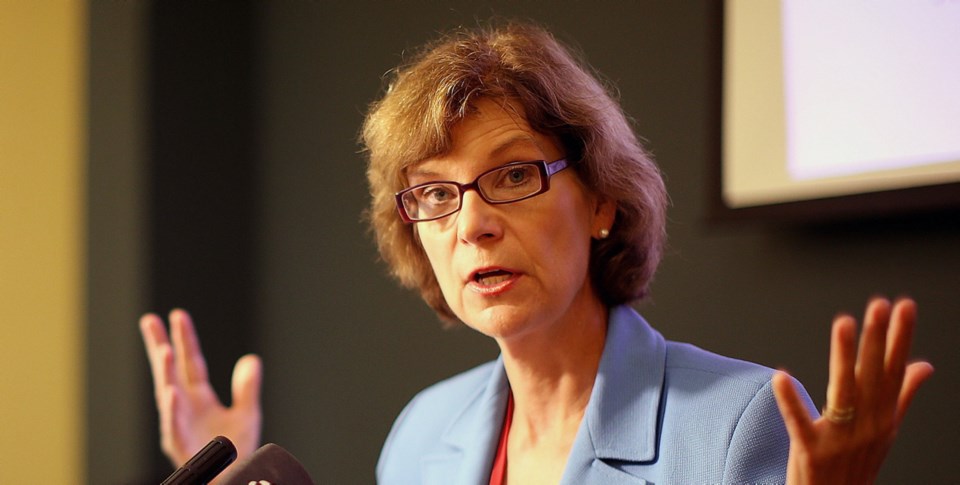Seniors who live in privately run care homes are far more likely to die in hospital than those who live in facilities run by public health authorities, according to a new report by B.C.’s seniors advocate.
The report, released by seniors advocate Isobel Mackenzie on Wednesday, shows that if you live in a seniors facility run by a private company or non-profit organization, you are 32 per cent more likely to be sent to the hospital emergency department. Once there, those seniors have a 54 per cent higher chance of dying inside the hospital than those who live in a care home run by a public health authority, according to the report.
Mackenzie called the discrepancy “stunning” and wrote that the private care operators appear to be persistently failing compared to publicly run facilities when it comes to keeping seniors out of hospital emergency rooms.
“Hospitals are not the best place for the frail elderly,” Mackenzie said in a statement accompanying her research.
“Issues related to deconditioning and the anxiety of unfamiliar places and interrupted routines can have a significant impact on the health and well-being of the frail elderly population. We also know that most people want to die at home and for many of our frail and elderly seniors, ‘home’ is the residential care facility. With a rate more than double the public facilities, we really need to ask why contracted care facilities are seeing their residents die in the hospital.”
B.C.’s Office of the Seniors Advocate monitors and analyzes issues related to seniors. While the office reports directly to the Minister of Health, it also has a special mandate in legislation giving it unique investigative powers.
Mackenzie’s report also shows a senior from a privately run facility will stay in hospital on average 32 per cent longer, opening up an increased risk of danger for seniors due to stress, fragility, a lack of mobility in hospital beds and the risk of hospital-acquired infections.
Fixing the problem, by reducing the hospitalization rates of private care homes, could save B.C.’s health system $16 million a year and free up 15,481 beds, estimated Mackenzie.
Almost 28,000 seniors in B.C. live in 293 publicly subsidized care facilities. Roughly one-third of beds are operated by a public health authority, with the rest run by contractors (including both private companies, non-profits and religious organizations) who get funding from the government.
Mackenzie wrote she was compelled to conduct her research after working alongside front line staff in six B.C. hospitals and hearing from doctors and nurses that it was predictable to see some patients admitted because they came from care homes with high hospital referral rates.
“The data do support the first observation from emergency department clinicians that private care facilities are sending residents to the emergency department more frequently than public facilities, even though the data indicate they care for less complex and frail residents,” Mackenzie wrote in the report.
“The data also support the observation from some clinicians that, all things being equal, the contracted care facilities are not accepting the residents back to the facility as quickly as the public facilities, resulting in longer lengths of stay, higher conversion to alternative level of care (ALC) and higher rates of death in hospital.”
The most common ailment that results in a senior’s death in hospital is pneumonitis, pneumonia, sepsis, hip fractures, congestive heart failure and progressive lung diseases.
Why private facilities have such higher hospitalization rates was not answered in Mackenzie’s research, though she was able to conclude that the number of funded direct care hours per senior didn’t affect the ER transfers.
Mackenzie questioned whether the skill mix of private-care staff are a factor, as well as training and lack of clinical leadership. Private care workers are generally paid lower wages than in publicly-run facilities and are sometimes fired en masse by private operators and then rehired in a practice known as contract flipping, which can lead to instability in a care home’s workforce, she wrote.
“There is a problem — that is clear from the data — but we cannot find solutions if we do not understand what is causing the problem,” wrote Mackenzie. “Undoubtedly, some contracted care providers will be uncomfortable with some of these questions and fixing the problem may have a financial impact on the care home operators’ profitability. However, fixing the problem may also bring the care home operators more resources that will allow them to improve the outcome of care for their residents, and that is a goal that we should all embrace.”
Private care homes attacked Mackenzie for the report, suggesting her research should be peer-reviewed by a third party for accuracy and accusing her of instilling “fear and uncertainty” into the senior care system.
“Unfortunately, this flawed report appears to have been produced at the last minute and is filled with questionable suppositions and political buzzwords, rather than independent research,” said Daniel Fontaine, CEO of the B.C. Care Providers Association, which represents most of the province’s private contractors.
Fontaine said the report only looked at a small number of overall visits by seniors to emergency departments, is not representative of rural and remote areas of the province and did not substantiate whether the visits to the ER were inappropriate or not.
The Denominational Health Association, which represents faith-based private contractors, such as the Baptist, Lutheran and Good Samaritan housing societies, said it was not consulted by the senior’s advocate about the research and also disagreed with the conclusions.



